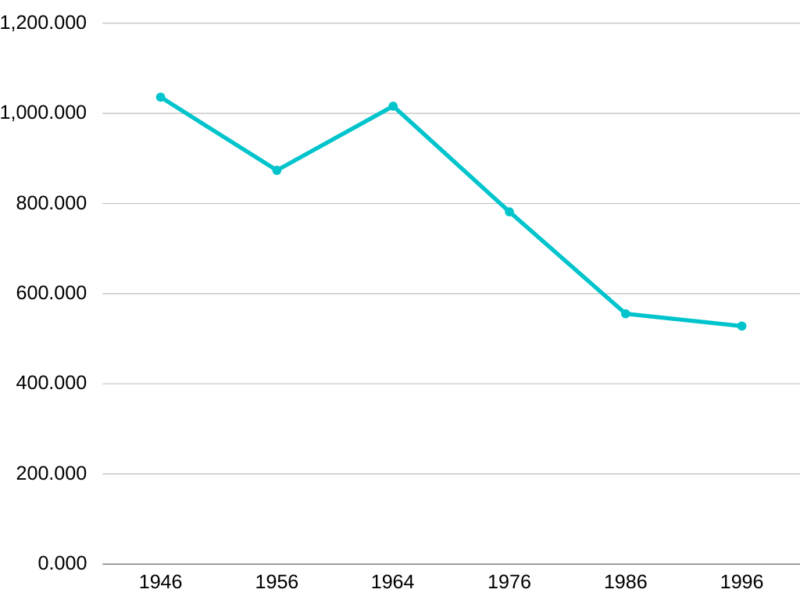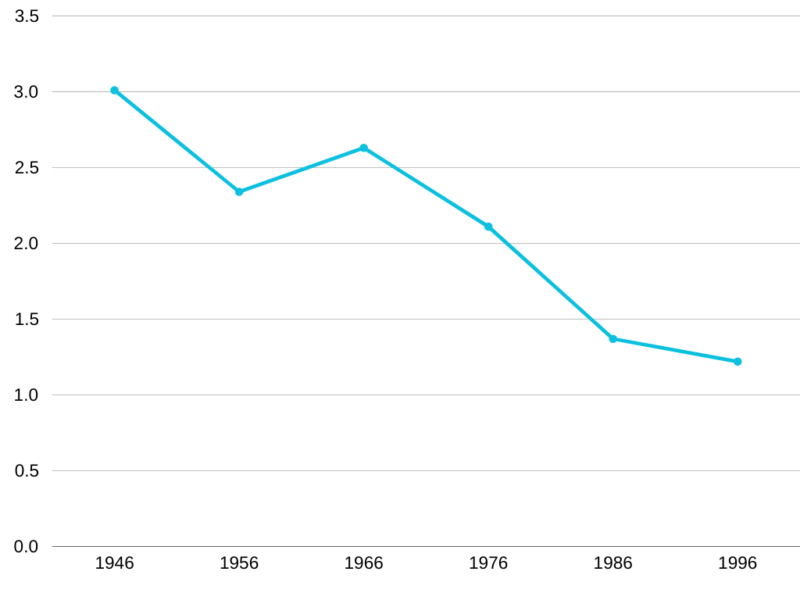Postwar period, baby boom and (temporary) demographic expansion baby boom e (temporanea) espansione demografica
Nel secondo dopoguerra il numero dei nati vivi torna ai livelli antecedenti il conflitto e, contemporaneamente, il tasso di mortalità scende al 10%, valore mantenuto fino a giorni nostri. Nei tre anni dal 1946 al 1948 il numero dei nati vivi superò il milione. Nei 14 anni successivi, tra il 1949 e il 1963, nascevano annualmente tra gli ottocentomila e i novecentomila bambini. Nel 1964 venne toccato nuovamente il picco del milione. Fu l’ultimo anno in cui in Italia si registrano così tante nascite.
Contemporaneamente, tra il 1946 e il 1971, sono emigrati all’estero, soprattutto verso il Nord Europa, 2,9 milioni di italiani. Nel ventennio successivo alla Seconda guerra mondiale, aumenta la migrazione interna: dalle aree rurali, dal Mezzogiorno e in parte dal Nord-est, soprattutto verso Lombardia, Piemonte e Lazio. Negli anni successivi al 1964 –anno in cui si registra l’ultimo picco di nascite- i nati vivi diminuiscono, fino a dimezzarsi in poco più di una generazione.
1977 is the year that marks an important stage in Italy's demographic decline: for the first time the fertility rate falls below 2. In the absence of migration and with a constant mortality rate, the average of two children per woman is what guarantees population replacement. Since more males are born than females (for every one hundred females, about 106 males are born) and the probability of reaching reproductive age is less than 100 percent, conventionally, the value of fertility that ensures replacement is 2.1.

Live births 1946-1996

Average number of children per woman (1946-1996)
In the 1970s and 1980s, both domestic and outward migration flows decrease. Despite the gradual decline in the fertility rate, the population continues to increase because life expectancy increases from 65 years for women and 62 for men in 1946 to 80 years for women and 74 for men in 1993. This increase of about 15 years over 47 years reflects the remarkable advances in public health, nutrition, living and working conditions in Italy during this period. Net of emigration, the Italian population increased from 45.5 million in 1946 to 57.3 in 1996. [3-Continued. The first two chapters were published HERE and HERE].
Sources:
Storia demografica dell’Italia dall’Unità a oggi, Istat, 7 febbraio 2023.
Popolazione residente per sesso, nati vivi, morti, saldo naturale, saldo migratorio, saldo totale e tassi di natalità, mortalità, di crescita naturale e migratorio totale – Anni 1862-2014 ai confini attuali, serie storiche.istat.it.
A maverick of nonconformist thought, he writes for several newspapers and blogs. He is interested in demographic dynamics, history, geopolitics and "fashionable ideologies."









devi metterti il cuore in pace, nel 2050 la popolazione che nasce e vivra’ in Italia sara composta esclusivamente da una miscellanza di varie etnie…
L’ etnia italiana conserva comunque enormi influenze africane susseguenti alla sconfitta dell impero romano nel 216 s. c. da parte di Annibale e susseguente occupazione che rasenta il ventennio. Tale etnia scomparira’ del tutto… o quasi e senz altro si migliorera’ notevolmente,
per la legge di Pende :Lussureggiamento degli ibridi….
C’è un limite alle scemità che si possono sopportare senza rispondere.
L’esercito di Annibale era composto da un numero oscillante fra i 30 e i 110.000 uomini, di cui circa metà perirono in battaglia poco dopo l’invasione dell’Italia. Di quelli superstiti, comunque, una larghissima fetta era composta da iberi, liguri e galli, quindi tutt’altro che “africani”.
E anche i cosiddetti “africani”, erano popolazioni BIANCHE, con scarsa o nulla ibridazione dall’Africa nera propriamente detta, da cui erano separate dal Sahara. Le recenti ibridazioni sono dovute al traffico di schiavi islamico, il cui impatto demografico è notevolmente diverso da quello praticato nel mondo antico.
Anche ammettendo che i soldati di Annibale possano aver avuto un certo impatto sulle popolazioni della penisola – allora non ancora rimescolate e omogeneizzate dalla colonizzazione romana e dalle invasioni barbariche – attraverso lo stupro di guerra di qualche centinaio di migliaia di donne galliche, liguri e greco-italiche, parliamo comunque per lo più di ibridazioni fra popolazioni europee (di cui una parte etnicamente già presente nella Penisola: liguri e galli), comprendendo in questo novero anche quelle nordafricane di mauri, numidi e libi che – come si vede da TUTTE le rappresentazioni artistiche antiche – erano ben differenti dagli “africani” come li intendono gli ignoranti un tanto al chilo attuali e appena distinguibili dalle popolazioni del nord del Mediterraneo, principalmente per un colore della pelle leggermente più olivastro e una generica prevalenza di capelli scuri (ancorché persone dai capelli biondi sono registrate fra i tuareg ancora in età storica).
Questo è quanto dovevo per far vedere la diversa preparazione fra uno che ha studiato e uno che si documenta sulle fiction di Netflix. I lettori poi potranno farsi la loro idea e decidere se stare dalla parte della storia scientifica o della propaganda pro-immigrazionista.
Chi spara scemenze danneggia anche te: digli di smettere.
La teoria che la presenza dell’esercito di Annibale abbia avuto una “enorme influenza” sul pool genetico della penisola è risibile per i vari motivi elencati da Emanuele Mastrangelo. Del resto, ammettendo questa balzana teoria, allora i vari eserciti imperiali germanici che sono discesi in Italia dovrebbero averci reso tutti biondi e con gli occhi azzurri.
Madre mía, como se bastardea un buen trabajo, serio, profundo del Sr. Umberto Camillo Iacoviello y de la gravedad para el futuro de Italia y en segundo término Europa, que tiene muchas explicaciones, pero escasas o nulas soluciones y ello es otra característica de la decadencia del Oxidente (Occidente con “X” porque está oxidado en ideas y proyectos superadores al neoliberalismos), Creo que introducir temas intrascendentes como lo de Anibal o de muchos otros invasores en el viejo mundo no aporta ningún argumento para dar alguna idea superadora de cómo salir de esta decadencia demográfica que es “crónica de una muerte anunciada”